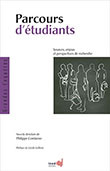Parcours d’étudiants - Sources, enjeux, et perspectives de recherche [Student trajectories: sources, issues, and research perspectives]

France currently has over 2.6 million higher education students. In a context of mass higher education and successive reforms, the training, occupational futures, and living conditions of students constitute major issues that require detailed analysis. It is crucial to study connections between student living conditions, transition to adulthood, and trajectories.
An original study of students
This work offers a panoramic view of the different methods for analyzing student trajectories, together with comparisons and findings. It differs from other works on the subject by the diversity of sources and approaches used and the many topics discussed. Entry into adulthood, couple formation, parenthood, leaving the parental home, internal and international mobility, occupation plans, material and financial conditions, transition from education to the job market—all these aspects need to be taken into account if we want to analyze the complexity of student trajectories and outcomes.
The other originality of the work is that its authors are from both different disciplines (demography, sociology, education science, economics, geography, statistics) and different institutions.
Analyzing training trajectories and mobility
Sequence analysis is used to measure the educational trajectories of students in Île-de-France, the region that encompasses Paris (Chapter 3). While most students started and completed their studies at a single university, students enrolled in Paris institutions are more socially privileged than those enrolled in the city’s outskirts (45% and 18% respectively). By contrast, socially underprivileged students are more likely to leave university. In Chapter 12, data from a statistical base on students run by the French government’s Directorate of Research, Projections, and Performance in education were used to measure students’ geographic mobility within France. The findings reveal university hierarchies and networks as well as mobility between universities. Chapter 4 focuses on the trajectories of students at the University of Ouagadougou; these students are no longer followed when they switch to another university but they nevertheless provide data for comparison with French universities. Chapter 13 investigates student (im)mobility: international mobility concerns only a small proportion of students, most of them socially selected.
Higher education and transition to adulthood: specificities and inequalities
Students in France differ from students in other European countries (Chapter 10). Their residential autonomy is greater; for this criterion France comes just behind Nordic and German-speaking countries. A much greater proportion of French students than students from any other country leave the parental home in order to live alone (25%), but only half as many leave to live with a partner either with or without children. 4.5% of French students have children, a figure that has remained stable for 10 years (Chapter 8). While some student parents had children before a return to school, most pregnancies that occur during higher education are unwanted (Chapter 9). Student parents in this situation encounter more difficulties and do not succeed as well as non-parents.
Last, income inequality creates new fracture lines. The amount and origin of students’ means, which vary by social characteristics, affect how their studies proceed and their academic performance; they also impact their transition to adulthood (Chapters 1 and 7). This analysis of student living conditions is further developed by way of local surveys of individual universities (Chapter 2).
International trajectories
In addition to the chapters on the University of Ouagadougou and young Europeans’ departure from the parental home, there is a chapter on the findings of the Eurostudent, Cheers, and Reflexe surveys on student trajectories in Europe (Chapter 6) and one on international student flows and counter-flows and the heavy proportion of Chinese students involved (Chapter 11).
Entering the labor market
The status fall experienced by higher education graduates upon entering the job market (the case for 1 in 3 students) has impacted the range of study programs offered at universities in France as well as student study program choices. As job market entry conditions have worsened, institutions of higher learning have changed the content and organization of their programs to facilitate graduate employment (12% of higher education graduates in 2010 opted for a professional program, whereas this type of training was virtually non-existent in France in the early 2000s), and universities have reinforced their career orientation and placement services (Chapter 5). France is ranked at an intermediate level among European Union countries (Chapter 6).
Source: Cordazzo P. (dir.), 2019. Parcours d’étudiants. Sources, enjeux et perspectives de recherche. Ined éditions
Contact: Philippe Cordazzo
Online: September 2019
